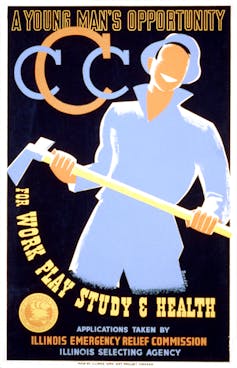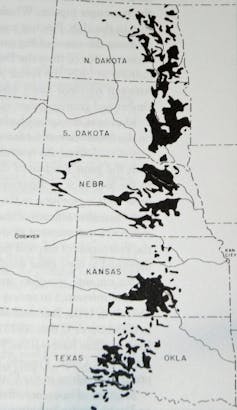FDR's forest army: How the New Deal helped seed the modern environmental movement 85 years ago
- Written by Benjamin Alexander, Lecturer in social science, New York City College of Technology, City University of New York
Eighty-five years ago, on April 5, 1933, President Franklin D. Roosevelt signed an executive order[1] allocating US$10 million for “Emergency Conservation Work.” This step launched one of the New Deal’s signature relief programs: the Civilian Conservation Corps[2], or CCC. Its mission was to put unemployed Americans to work improving the nation’s natural resources, especially forests and public parks.
Today, when Americans talk about “big government[3],” the connotation is almost always negative. But as I show in my history of the Corps[4], this agency infused money into the economy at a time when it was urgently needed, and its work had lasting value.
Corps workers planted trees, built dams and preserved historic battlefields. They left trail networks and lodges in state and national parks that are still widely used today. The CCC taught useful skills to thousands of unemployed young men, and inspired later generations to get outside and help conserve America’s public lands.
CCC recruits at work in Great Smoky Mountain National Park, 1936.The spiritual value of outdoor work
Roosevelt had sketched out much of his concept for the CCC well before his inauguration on March 4, 1933. Proposing the corps on March 21, he asserted that it would be “of definite, practical value” to the nation and the men it enrolled:
“The overwhelming majority of unemployed Americans, who are now walking the streets and receiving private or public relief, would infinitely prefer to work. We can take a vast army of these unemployed out into healthful surroundings. We can eliminate to some extent at least the threat that enforced idleness brings to spiritual and moral stability.”
Congress enacted the bill on March 31, and Roosevelt signed it that day. Although there was no precedent for such a vast mobilization, enrollment started a week later in New York, Baltimore, Washington, D.C., Pittsburgh and other major cities, then fanned out across the country. By midsummer, some 250,000 men aged 18 to 25 had signed up. Their six-month term might be spent at one camp or several; it might be located across the continent or, rarely, just across town.
 Poster by Albert M. Bender, Illinois WPA Art Project, Chicago, 1935.
Library of Congress[5]
Poster by Albert M. Bender, Illinois WPA Art Project, Chicago, 1935.
Library of Congress[5]
Another day, another dollar
CCC recruits came from families on relief. Agents from local welfare offices screened prospects, then passed them along to the Army for a physical examination and a final decision. The Army also managed the huge task of transporting successful applicants to hundreds of work camps[6]. The corps established operations in all 48 states and the territories of Puerto Rico, Alaska, Hawaii and the Virgin Islands, as well as a separate American Indian division[7].
Most enrollees were young unmarried men, but the CCC also created special companies of war veterans. This policy was Roosevelt’s response to the 1932 Bonus March[8], in which thousands of World War I veterans camped out in Washington, D.C., demanding early payment on promised military service bonuses, only to be evicted at gunpoint by order of then-president Herbert Hoover. (Some scholars believe this debacle helped clinch Roosevelt’s election[9] later that year.)
CCC recruits could only bring a single trunk; tools were provided on-site. Many Corps members packed musical instruments, and some brought their dogs, which became company mascots. At the start many recruits slept in tents and bathed in nearby rivers. Those without experience in the great outdoors learned key lessons fast, such as how to avoid using poison ivy for toilet paper. Some succumbed to homesickness and dropped out, but most adjusted, forming baseball teams, music combos and boxing leagues.
Although the CCC was a civilian organization, the camps were run by the Army and bore some of its hallmarks. Dining facilities were called mess halls, beds had to be made tightly enough to bounce a quarter off them, and workers woke to the sound of reveille and went to sleep with taps. Commanding officers had final say over most issues.
At work sites, the Agriculture and Interior departments – custodians of U.S. public lands – were in charge. CCC members planted 3 billion trees[10], earning the nickname “Roosevelt’s tree army.” This work revitalized U.S. national forests and created shelter belts[11] across the Great Plains to reduce the risk of dust storms. The corps also surveyed and treated forests to control insect pests and created forest fire prevention systems. Over its decade of operation, 42 enrollees and five supervisors died fighting forest fires.
 Major planting areas for the Shelterbelt Project, 1933-42.
U.S. Forest Service[12]
Major planting areas for the Shelterbelt Project, 1933-42.
U.S. Forest Service[12]
Corps members created and landscaped 711 state parks[13], and built lodges and hiking trails in dozens of national parks and monument areas. Many of these facilities are still in use today. Attractions including the Grand Canyon, Grand Teton and Yellowstone National Parks, and Civil War battlefields at Gettysburg and Shiloh bear signatures of CCC work.
For their labors, corps members received $30 a month – but as a condition of enrollment, the CCC sent $22 to $25 each pay period home to their families. Still, at Depression prices, $5 was enough to visit nearby dance halls and meet girls once or twice a week. These forays sometimes ended in fights with jealous local men, but also led to many lifelong marriages.
Ripple effects
In total, close to 3 million workers and their families received support from the CCC between 1933 and 1942. The corps also provided jobs for well over 250,000 salaried employees, including reserve military officers who ran the camps and so-called “local experienced men” – unemployed foresters who lived near the camps and were hired mainly to help supervise enrollees on the job.
Camps also hired unemployed teachers to offer informal evening classes. Some 57,000 enrollees learned to read and write[14] during their CCC stints. Camps offered many other classes, from standard subjects like history and arithmetic to vocational skills such as radio, carpentry and auto repair.
Like other New Deal programs, the CCC had flaws. Party patronage heavily influenced hiring of salaried personnel. Although the law creating the CCC banned racial discrimination, black enrollment was capped[15]. Many African-American enrollees were housed in “colored camps” and could only go into town for recreation and romance if black communities existed to serve them.
 A racially mixed CCC Company in Pineland, Texas in 1933, with African-American members grouped at far right.
University of North Texas Libraries., CC BY-ND[16][17]
A racially mixed CCC Company in Pineland, Texas in 1933, with African-American members grouped at far right.
University of North Texas Libraries., CC BY-ND[16][17]
The CCC also discriminated socially, enrolling young men with families but excluding rootless transients who wandered from town to town in search of work and food. These men could have reaped great benefits from the CCC, but its leaders imagined an unbridgeable cultural gap between young men who came from families and others who came from the byroads. And the corps only enrolled men, although Eleanor Roosevelt convinced her husband to let her and Labor Secretary Frances Perkins organize a smaller network of “She-She-She” camps[18] for jobless women.
Congress terminated funding for the CCC in 1942, after the United States entered World War II, although Roosevelt argued[19] that it still played an essential role. Many men who had gained physical strength and learned to handle Army discipline in the CCC later entered the armed forces.
The tree army’s legacy
Beyond its physical impact, the corps helped to broaden public support for conservation. In the 1940s and 1950s, youth groups such as the Oregon-based Green Guards[20] volunteered in local forests clearing flammable underbrush, cutting fire breaks and serving as fire lookouts. Others, such as the Student Conservation Association[21], advocated for wilderness protection and conservation education. Hundreds of former CCC enrollees helped lead these efforts. Today many teenagers work in national parks[22], forests[23] and wildlife refuges[24] every summer.
Although it is hard to picture a CCC-style initiative winning political support today, some of its ideas still resonate. Notably, the Obama administration’s economic stimulus plan[25] and some proposals for upgrading U.S. infrastructure[26] present federal spending on projects that benefit society as a legitimate way to stimulate economic growth. The CCC combined that strategy with the idea that America’s natural resources should be protected so that everyone could enjoy them.
References
- ^ executive order (www.presidency.ucsb.edu)
- ^ Civilian Conservation Corps (www.history.com)
- ^ big government (www.huffingtonpost.com)
- ^ history of the Corps (jhupbooks.press.jhu.edu)
- ^ Library of Congress (en.wikipedia.org)
- ^ hundreds of work camps (www.ccclegacy.org)
- ^ American Indian division (www.archives.gov)
- ^ 1932 Bonus March (www.theguardian.com)
- ^ helped clinch Roosevelt’s election (www.smithsonianmag.com)
- ^ 3 billion trees (www.fs.usda.gov)
- ^ shelter belts (www.pri.org)
- ^ U.S. Forest Service (commons.wikimedia.org)
- ^ 711 state parks (www.nps.gov)
- ^ learned to read and write (www.archives.gov)
- ^ black enrollment was capped (livingnewdeal.org)
- ^ University of North Texas Libraries. (livingnewdeal.org)
- ^ CC BY-ND (creativecommons.org)
- ^ “She-She-She” camps (www2.gwu.edu)
- ^ argued (www.nps.gov)
- ^ Green Guards (fhsarchives.wordpress.com)
- ^ Student Conservation Association (www.thesca.org)
- ^ national parks (www.nps.gov)
- ^ forests (www.fs.fed.us)
- ^ wildlife refuges (www.fws.gov)
- ^ economic stimulus plan (www.pbs.org)
- ^ upgrading U.S. infrastructure (www.democrats.senate.gov)
Authors: Benjamin Alexander, Lecturer in social science, New York City College of Technology, City University of New York

